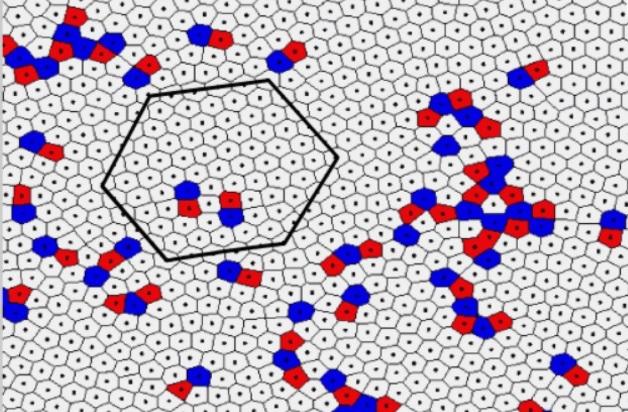
Credit: Scientific Reports
Scientists from the Joint Institute for High Temperatures Russian Academy of Sciences (JIHT RAS) and Moscow Institute of Physics and Technology (MIPT) have experimentally confirmed the presence of an intermediate phase between the crystalline and liquid states in a monolayer dusty plasma system. The theoretical prediction of the intermediate – hexatic – phase was honoured with the Nobel Prize in Physics in 2016: the prize was awarded to Michael Kosterlitz, David Thouless and Duncan Haldane with the formulation “for theoretical discoveries of topological phase transitions and topological phases of matter.”
In a scientific article in the journal Scientific Reports, the JIHT RAS scientists published their observations and detailed descriptions of experiments, during which they first observed the hexatic phase in two-dimensional structures in plasma. The paper describes methods for accurately identifying phase transition points and presents a detailed analysis of the structural properties of such a system. The data obtained during the experiment are fully consistent with the Berezinsky-Kosterlitz-Thouless theory.
“Our design of experiment makes it possible to clearly observe a two-stage process of crystal melting and to identify the points of the phase transition “solid-hexatic phase ” and “hexatic phase-liquid,” said Ph.D. Elena Vasilieva, the senior researcher in Laboratory of Dusty Plasma Diagnostics, JIHT RAS. “The long time of the experiment, sufficient to establish a stationary state of the system, in combination with precise methods of controlling the temperature of particles, made it possible to smoothly change the parameters of the system and “catch” the hexatic phase.”
According to Elena Vasilieva, despite the existence of the Berezinsky-Kosterlitz-Thouless theory for more than 40 years, which predicts two-stage melting from a crystal to a liquid phase with the formation of an intermediate hexatic phase, it has not yet been possible to study these processes in laboratory plasma systems. Two-dimensional transitions have already been observed in polymer colloids, magnetic bubbles in thin films, liquid crystals, and superconductors, but there has been no experimental evidence of two-stage melting in dusty plasmas for a long time.
“Our experiment was successful due to a number of factors. For example, we used an unconventional approach to form a monolayer dusty system, namely we used particles with a metal surface that are capable of absorbing laser radiation and converting it into the energy of their own motion. The particle system had a long time for relaxation before recording the experimental series. In addition, a homogeneous laser beam was used to uniformly influence the structure and its precise heating,” commented Oleg Petrov, the director of the Joint Institute for High Temperatures Russian Academy of Sciences.
The study of the physical properties of two-dimensional systems is of great practical importance. Such research is now rapidly developing, promising in the future new materials with desired properties and devices based on them in microelectronics, medicine for DNA sequencing, etc.
The results presented in the article were obtained with the support of the Russian Science Foundation in the framework of the project “Active Brownian motion of Coulomb particles in plasma and superfluid helium.”
###
Media Contact
Alena Akimova
[email protected]
Related Journal Article
http://dx.




